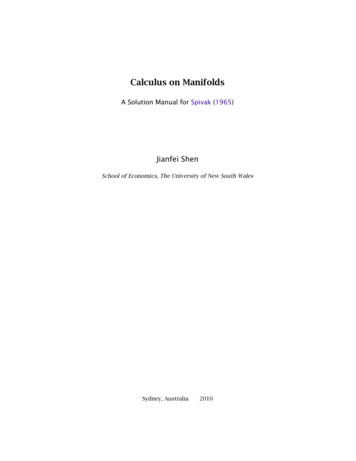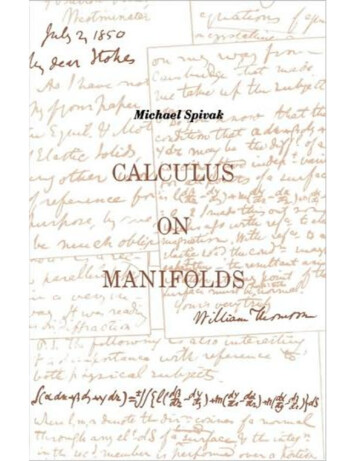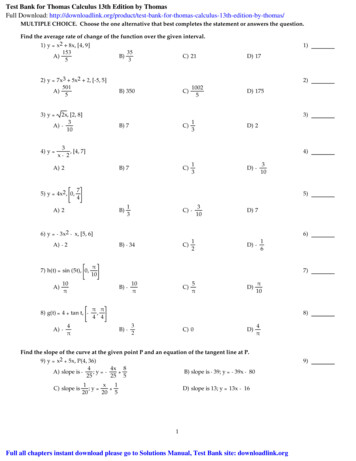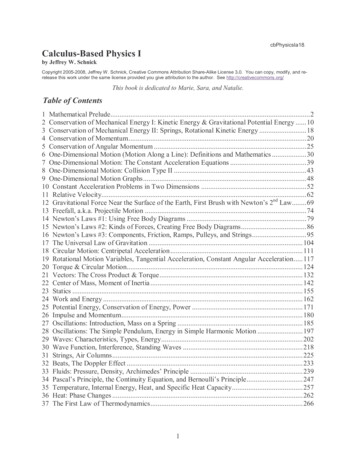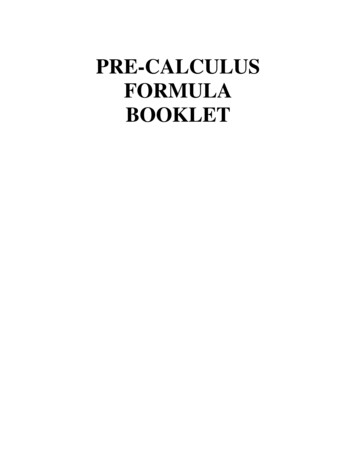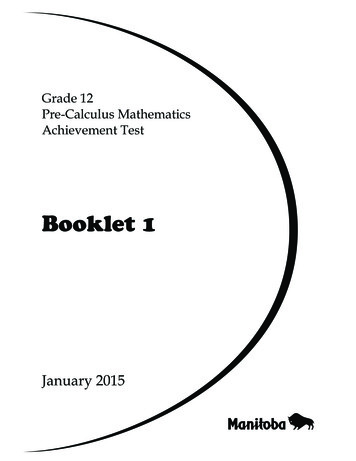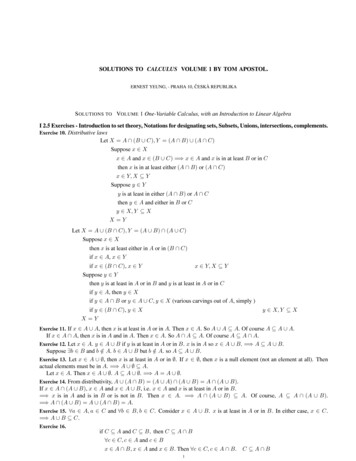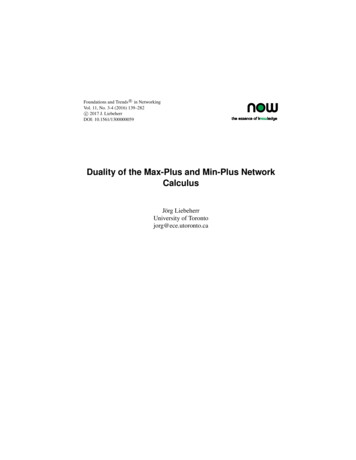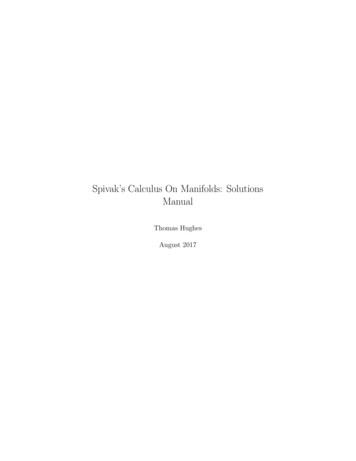
Transcription
Spivak’s Calculus On Manifolds: SolutionsManualThomas HughesAugust 2017
Chapter 1Functions on EuclideanSpace1.1 Prove that x Pni 1 xi Proof. If {e1 , e2 , . . . , en } is the usual basis on Rn , then we can writex x1 e1 x2 e2 . . . xn enand thus x nXxi ei nXi 1 xi ei i 1nXi 1 xi ei nX xi i 11.2 When does equality hold in Theorem 1-1(3)?Proof. Notice in the proof that we get x y 2 nnnXXX(xi )2 (yi )2 2xi yi x 2 y 2 2 x y i 1i 1i 1PnPnand so we have equality precisely when i 1 xi yi i 1 xi yi and xand y are dependent. That is, when x and y are dependent and sgn(xi ) sgn(yi ) for all i. That is, when one is a non-negative multiple of theother.1.3 Prove that x y x y . When does equality hold?Proof. x y x ( y) x y x y Conditions for equality are the same as in 1.2, for x and y.1
1.4 Prove that x y x y .Proof. Notice x x y y x y y Thus x y x y Similarly, y y x x y x x x y x Thus y x x y x y x y So, combining these results yields x y x y x y which implies x y x y as desired.1.5 The quantity y x is called the distance between x and y. Prove andinterpret geometrically the “triangle inequality”: z x z y y x Proof. z x z y y x z y y x Geometrically, we havey z y y x x z zx 1.6 Let f and g be integrable on [a, b].(a) Prove thatRbaf ·g Rbaf22 12 R 12b· a g2 .
(b) If equality holds, must f λg for some λ R? What if f and g arecontinuous?(c) Show that Theorem 1-1(2) is a special case of (a).Proof. (a) One way to prove this would be to observe that 1-1(2) impliesthat! 21! 21nnnXXX22f (tk )g(tk ) xk (f (tk )) xk(g(tk )) xkk 1k 1k 1Notice, by integrability, all the sums can be considered functions ofRbRbthe tagged partition Ṗ, such that each will approach a f · g, a f 2Rband a g 2 , respectively, when Ṗ 0. Thus, by continuity ofthe square root function and the absolute value, taking the limit asṖ 0 will give us the desired result.However, following Spivak’s hint, we observe that either there existsλ R such thatZ b0 (f λg)2aor, since (f λg)2 is nonnegative, for all λ RZ b0 (f λg)2aNotice from Lebesgue’s theorem of Riemann-integrability that in thefirst case we must have that f λg almost everywhere on [a, b], andthereforeZ bZ bf ·g λg2aaandbZf2 aWhich would give us thatvuZ bZ bu2f ·g λg tλ2abZλ2 g 2a!2bZg2sZ aabλ2 g 2aawhich can be rewritten asZbZf ·g aa3! 12bf2Za! 12bg2ZsZbg2 abf2Zabg2
In the second case, we have thatZ0 b(f λg)2 bZaf 2 2λbZaf · g λ2bZg2aaOn the right, we have a quadratic in λ which has no real roots sincethe inequality holds for all λ R. Thus!2bZf ·g4bZf2 4abZag2 0awhich implies!2bZf ·gZb af2abZg2awhich finally gives usZ! 12b f! 12bZ2g2! 21bZf ·g aabZfa2! 12bZg2aaThus, together, the results from both cases imply thatZbZf ·g ! 12bfa2Z·a! 12bg2aas desired.(b) No, in general, we may have f 6 λg and still have R 1 1 b 2 2 Rb 2 2. For example, takegfaa(f and(g 1,0,x 1elsewhere1,0,x 0elsewhereRbaf ·g 1 R 12 RR111 2 2Then 0 f · g 0 f 2g 0 while f 6 λg. However, if0f and g are continuous, then equality holds if and only if f λg forsome λ R. This follows from the theorem which states that if f iscontinuous on [a, b] and f 0 with f (x0 ) 0 for some x0 [a, b]Rbthen a f 0. The proof of this can be found in Exercise 7.4.4 fromthe solutions manual for Abbott’s Understanding Analysis.4
(c) Divide[a, b] into n sub-intervalsso that on the ith sub-interval, b ab aa n (i 1), a n i , we define f to bexif (x) qb anand g to beyig(x) qb anThenbZf ·g abZf2 ai 1nXxi yix2ii 1bZnXg2 anXyi2i 1which, by (a), gives us the desired inequality.5
Table 1.1: A poorly drawn graph of f6
1.7 A linear transformation T : Rn Rn is norm preserving if T (x) x ,and inner product preserving if hT x, T yi hx, yi.(a) Prove that T is norm preserving if and only if T is inner productpreserving.(b) Prove that such a linear transformation T is injective and T 1 is ofthe same sort.Proof. (a) Suppose that T is norm preserving. Then, by the polarizationidentity, we havehx, yi x y 2 x y 24and since T is norm preserving, we have T (x y) 2 T (x y) 24hT (x y), T (x y)i hT (x y), T (x y)i 4 and by linearity of T , we have hT (x) T (y), T (x) T (y)i hT (x) T (y), T (x) T (y)i4and by bilinearity of the inner product, we have hT x, T yiNow, suppose that T is inner product preserving. Thenpp T (x) hT (x), T (x)i hx, xi x (b) Suppose that T is norm preserving (and therefore, also inner productpreserving) and thatT (x) T (y)thenT (x) T (y) 0T (x y) 0 T (x y) 0 x y 0which implies thatx y 0x y7
Therefore, T is injective. Since injectivity of a linear transformationis equivalent to surjectivity, it follows that T 1 exists. To show thatT 1 is of the same sort, we show that it is norm preserving. ObservethatT 1 (y) x T (x) y 1.8 If x, y Rn are non-zero, the angle between x and y, denoted (x, y),hx,yiis defined as arccos x · y , which makes sense by Theorem 1-1(2). Thelinear transformation T is angle preserving if T is injective, and forx, y 6 0 we have (T x, T y) (x, y).(a) Prove that if T is norm preserving, then T is angle preserving.(b) If there is a basis x1 , . . . , xn of Rn and numbers λ1 , . . . , λn such thatT xi λi xi , prove that T is angle preserving if and only if all λi areequal.(c) What are all angle preserving T : Rn Rn ?Proof. (a) If T is norm preserving, then it is also inner product preservingand injective. Thus, if x, y 6 0, hT x, T yihx, yi arccos (x, y) (T x, T y) arccos T x · T y x · y so that T is also angle preserving.(b) This is not true. Take (( 1, 1), (1, 0)) (x1 , x2 ) as a basis for R2 .IfT (x1 ) 3x1T (x2 ) 3x2Then T is injective and has that λi are all equal. However, (x1 , x2 ) 3π4while (T x1 , T x2 ) π41.9 If 0 θ π, let T : R2 R2 have the matrix cos θsin θ sin θ cos θShow that T is angle preserving and if x 6 0, then (x, T x) θ.8
Proof. Observe that cos θ sin θsin θcos θ x1x1 cos θ x2 sin θ x2 x1 sin θ x2 cos θand cos θ sin θsin θcos θ y1y1 cos θ y2 sin θ y2 y1 sin θ y2 cos θNow, some rather tedious calculations show thathT x, T yi x1 y1 x2 y2 hx, yiand T x x and T y y which, together, imply that (T x, T y) (x, y) so that T is angle preserving. Again, a rather tedious calculation shows that2hx, T xi x cos θwhich implies that, for x 6 0 (x, T x) arccoshx, T xi x · T x 2 arccos x cos θ !2 x arccos(cos θ) θ1.10 If T : Rm Rn is a linear transformation, show that there is a numberM such that T (h) M h for h Rm .Lemma. Let T L(Rm , Rn ). Then there exists M 0 such that for allx admitting x 1, we have T (x) MProof of Lemma. Let x 1. Given the standard basis, {e1 , . . . , em }, onRm we may writex α1 e1 . . . αm em9
where αi 1 for all 1 i m. Thus T (x) T (α1 e1 . . . αm em ) α1 T (e1 ) . . . αm T (em ) α1 T (e1 ) . . . αm T (em ) T (e1 ) . . . T (em ) MProof of 1.10. From the Lemma, we get that there exists M 0 suchthat, if h 6 0, then hT M h 1T (h) M h T (h) M h n1.11 If x, y Rqand z, w Rm , show that h(x, z), (y, w)i hx, yi hz, wi and22 (x, z) x z . Note that (x, z) and (y, w) denote points in Rn m .Proof. Observe(x, z) (x1 , . . . , xn , z1 , . . . , zm )and(y, w) (y1 , . . . , yn , w1 , . . . , wm )and thush(x, z), (y, w)i nXxi yi i 1andmXzi wi hx, yi hz, wii 1vu nqmXuX22x2i (x, z) tzi2 x z i 1i 1 1.12 Let (Rn ) denote the dual space of the vector space Rn . If x Rn , define φx (Rn ) by φx (y) hx, yi. Define T : Rn (Rn ) by T (x) φx .Show that T is an injective linear transformation and conclude that every φ (Rn ) is φx for a unique x Rn .10
Proof. The linearity of the inner product implies the linearity of T . Toshow that T is injective, by linearity of T , it is sufficient to show thatker(T ) {0}. To that end, suppose thatT (x) 0thenφx 0so thatφx (x) 0hx, xi 0if and only ifx 0Thus ker(T ) {0} and T is injective. Moreover, since dim(Rn ) dim RN , injectivity of T implies surjectivity. Thus T is a bijection be tween Rn and (Rn ) . Thus each φ (Rn ) corresponds to a φx for somenunique x R .1.13 If x, y Rn , then x and y are called perpendicular (or orthogonal) ifhx, yi 0. If x and y are perpendicular, prove that222 x y x y Proof.222 x y hx y, x yi hx, xi 2hx, yi hy, yi hx, xi hy, yi x y 1.14 Prove that the union of any (even infinite) number of open sets is open.Prove that the intersection of two (and hence infinitely many) open setsis open. Give a counterexample for infinitely many open sets.Proof. Let x λ Oλ with each Oλ open. Then there exists λ such thatx Oλ . Since Oλ is open, there exists an open rectangle, A, such thatx A Oλ λ Oλ . Thus the arbitrary union of open sets is open. Asimple but tedious argument could be made to show that the intersectionof two open rectangles is, again, an open rectangle. Then the intersectionof two open sets being, again open is a simple corollary. Notice that \1 1 , {0}n nn 1Clearly, {0} does not contain any open rectangles, and is therefore notopen.11
1.15 Prove that {x Rn : x a r} is open.Lemma. There exists an open rectangle, U , such that U B0 (r) {x Rn : x r}Proof. Let U Πni 1 ( n , rn ). ThennX 2n Xr x xi r2ni 1i 122implying x r. Therefore U B0 (r).Corollary. There exists an open rectangle, U , such that U Ba (r) {x Rn : x a r} is open.Proof. By the transformation T (x) x a and the open rectangle U fromthe Lemma.Corollary. Ba (r) is open.Proof. Let x Ba (r). Then, from the Corollary, we get that there existsan open rectangle, U , such thatU Bx (r x a ) Ba (r)Therefore, Ba (r) is open.It is not to hard to apply the same idea backwards: every open rectanglecontains an open ball. Thus a set, A, is open if and only if for each x Athere exists Bx (r) such that Bx (r) A. This characterization of opensets is often easier to work with than the characterization provided in thebook. We will consider this as given for future exercises.1.16 Find the interior, exterior, and boundary of the sets.{x Rn : x 1}{x Rn : x 1}{x Rn : each xi is rational.}Proof. For the first, we have that the interior is {x Rn : x 1}, theexterior is {x Rn : x 1}, and the boundary is {x R : x 1}.For the second, we have that the interior is empty (every open rectanglein Rn will contain some points outside this set), the exterior is {x Rn : x 6 1}, and the boundary is the set itself.For the third, we have that both the interior and exterior are empty, andthe boundary is again the set itself.12
1.17 Construct a set A [0, 1] [0, 1] such that A contains at most one pointon each horizontal and each vertical line but boundary A [0, 1] [0, 1].Proof. Let A be the set of all points with rational coordinates in (0, 1) (0, 1). Then clearly boundary(A) [0, 1] [0, 1]. If x [0, 1] [0, 1] thenx (x1 , x2 ) where 0 x1 , x2 1. Thus, if B is an open set containingx, it follows that there exist 0 1 , 2 such that [x1 1 , x1 1 ] [x2 2 , x2 2 ] B [0, 1] [0, 1]. Density of Q in R and the existence of anirrational between any two reals implies that [0, 1] [0, 1] boundary(A).Thus boundary(A) [0, 1] [0, 1].1.18 If A [0, 1] is the union of open intervals (ai , bi ) such that each rationalnumber in (0, 1) is contained in some (ai , bi ), show that boundary(A) [0, 1] \ A.Proof. Notice, by openness of A, x boundary(A) implies x 6 A. Furthermore, by openness of [0, 1]c , x boundary(A) implies x 6 [0, 1]c . Ifx [0, 1] \ A and if B is open with x B, then B Ac 6 . Furthermore,by density of Q in R we also get that there exists a rational r B A, sothat B A 6 . Thus boundary(A) [0, 1] \ A.1.19 If A is a closed set that contains every rational number r [0, 1], showthat [0, 1] AProof. Suppose, to the contrary, that there exists x [0, 1] Ac . SinceA is closed, it follows that Ac is open and that therefore, there exists anopen B such that x B Ac . But, by density of Q in R, we knowthat there exists a rational r A B contradicting with B Ac . Thus[0, 1] A.1.20 Show that a compact set in Rn is closed and bounded.Proof. If K Rn is compact then clearly it is bounded, for if it wereunbounded, then {Πn1 ( k, k) : k N} would be an open cover of K whichadmits no finite subcover. To show that K is closed, let x K c andconsider the open cover of K given by x k Bk:k K2By compactness, there exists a finite subcover x ki Bki:1 i n2 i Thus Bx mini x k K c . Therefore, K c is open.213
1.21 (a) If A is closed and x 6 A, prove that there is a number d 0 suchthat y x d for all y A.(b) If A is closed, B is compact, and A B , prove that there is d 0such that y x d for all y A and x B.(c) Give a counterexample in R2 if A and B are closed but neither iscompact.Proof. (a) Let A be closed and x Ac . Since A is closed, there exists anopen B Ac with x B. So there exists an open ball Bx (r) Ac .cThus, if y A, then y (Bx (r)) . Thus y x r(b) Let A be closed and B be compact with A B . Since A is closedand A and B are disjoint, by (a), we know that for every x B thereexists dx 0 such that for all y A we have y x dx . So dx:x BBx2forms an open cover of B. By compactness of B, there exists a finitesubcover dx1dxmBx1, . . . , Bxm22So for all y A and 1 i m y xi y x x xi dThus, if x B then x Bxi 2xi for some i, an
However, following Spivak’s hint, we observe that either there exists 2R such that 0 Z b a (f g)2 or, since (f g)2 is nonnegative, for all 2R 0 Z b a (f g)2 Notice from Lebesgue’s theorem of Riemann-integrability that in the rst case we must have that f galmost everywhere on [a;b], and therefore Z b a fg Z b a g2 and Z b a f2 Z b a 2g2 Which would give us that
